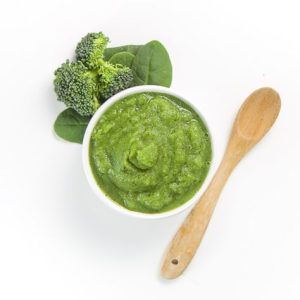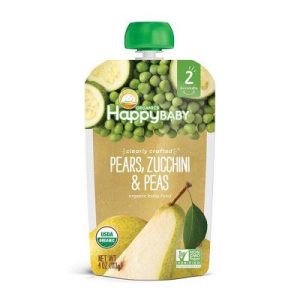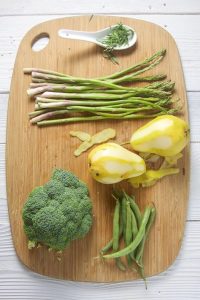Green vegetable puree is a fantastic first food for babies. They are packed with nutrients, easy to digest, and introduce little ones to a world of delicious flavors. But for new parents, venturing into the realm of baby food creation can seem daunting. Fear not! This guide will equip you with everything you need to know about making green vegetable purees for your baby.
The Power of Green: Why Choose Green Vegetables?
Green vegetables are nutritional powerhouses for babies. Here’s a breakdown of some key benefits:
Essential Vitamins and Minerals:
Green veggies are loaded with vitamins A, C, and K, vital for healthy growth and development.
Fiber for Gut Health:
The fiber content in green vegetables aids digestion and promotes a healthy gut microbiome.
A Foundation for Healthy Eating Habits:
Introducing a variety of green vegetables early on exposes babies to healthy flavors and textures, shaping their future preferences.

Choosing the Perfect Green Vegetables
With a vast array of green vegetables available, selecting the right ones can be overwhelming. Here are some suggestions to get you started:
-
Avocado: This creamy and mild-flavored fruit (yes, it’s a fruit!) is a great first green puree for babies.
-
Broccoli: Steamed or roasted broccoli florets offer a slightly sweet and slightly bitter taste, perfect for introducing new flavor profiles.
-
Zucchini: This versatile veggie is naturally sweet and smooth, making it a crowd-pleaser among babies.
-
Green Beans: Cut into small pieces and steamed, green beans add a subtle vegetal flavor and essential vitamins.
-
Peas: Mashed or pureed peas are a good source of protein and fiber, and their sweetness is generally well-liked by babies.
Preparing and Pureeing Green Vegetables
Now that you’ve chosen your green warriors, let’s explore the fun part: creating the puree!
-
Steaming or Boiling: Steaming or boiling are the healthiest cooking methods for preserving nutrients in green vegetables.
-
Keep it Simple: For first foods, avoid adding spices, herbs, or salt. Let the natural flavors of the vegetables shine through.
-
Embrace the Mash: A simple mash with a fork or spoon can be sufficient for younger babies.
-
Pureeing Perfection: A food processor or blender allows you to create a smoother consistency for older babies who are transitioning to more textured foods.

Green Puree Combinations for the Adventurous Eater
As your baby’s palate matures, you can experiment with flavor and texture combinations. Here are some ideas:
-
Avocado and Peas: This creamy and protein-packed puree is a delicious and nutritious combination.
-
Broccoli and Apple: The sweetness of the apple balances the slightly bitter taste of broccoli, creating a well-rounded flavor profile.
-
Green Bean and Sweet Potato: This vibrant green and orange combo offers a delightful contrast in color and taste.
-
Spinach and Pear: The earthy notes of spinach are perfectly complemented by the pear’s sweetness in this unique and healthy puree.
Remember, these are just starting points. Feel free to get creative and explore different flavor combinations!

Storing and Reheating Green Vegetable Puree
-
Storage Solutions: Homemade puree can be stored in airtight containers in the refrigerator for up to 3 days or frozen in ice cube trays for longer storage.
-
Reheating Tips: Thaw frozen puree in the refrigerator overnight or by running warm water over the sealed container. Reheat only the amount you will use and avoid reheating multiple times.
Beyond the Puree: Exploring Textures
As your baby progresses, introduce them to different textures. Here’s how:
-
Start Smooth, Progress Gradually: Begin with smooth purees and gradually mash or chop vegetables to create a thicker consistency.
-
Finger Foods Fun: Around 6 months, offer steamed or roasted florets of broccoli, green beans, or avocado slices for self-feeding exploration.
-
Gagging is a Natural Reflex: Don’t be alarmed if your baby gags on thicker textures. This is a normal reflex as they learn to move food around their mouth.
Making Mealtime a Positive Experience
Mealtime with a baby can be messy, but it should also be enjoyable. Here are some tips:
-
Create a Relaxed Atmosphere: Sit together at a table or highchair and make eye contact with your baby.
-
Let Your Baby Take the Lead: Allow your baby to explore the puree with their hands or a spoon at their own pace.

The Wonderful World of Baby-Led Weaning with Green Vegetables
Baby-led weaning (BLW) is a feeding approach that allows babies to explore solid foods themselves from a young age. While purees can be a great introduction to flavors, BLW encourages self-feeding and experimentation with textures. So, how can green vegetables fit into BLW?
-
Steamed or Roasted Green Veggies: Large florets of broccoli, green beans, or even avocado slices can be perfect for little hands to grasp and gum. Make sure they are soft enough for them to mash between their gums.
-
Size Matters: Cut or break down vegetables into safe-to-eat shapes that are larger than your baby’s fist to prevent choking.
-
Gagging vs. Choking: Remember, gagging is a normal reflex as babies learn to move food around their mouths. Choking is much less common. If you are concerned about choking hazards, talk to your pediatrician.
-
Let Them Lead the Way: Place the steamed or roasted veggies on your baby’s tray and allow them to explore at their own pace. They might gum on them, suck on them, or even throw them on the floor (which is all part of the learning process!).
-
Supervision is Key: Always supervise your baby closely during mealtimes, regardless of whether they are eating purees or practicing BLW.
Green Vegetable Purees for Every Stage
The beauty of green vegetable purees is their versatility. Here’s how to adapt them to your baby’s developmental stages:
-
Early Stages (4-6 months): Stick to single-ingredient purees with a smooth consistency. Avocado, zucchini, and peas are all great options.
-
Later Stages (6-8 months): Introduce thicker consistencies by mashing vegetables with a fork or using a hand blender with a slightly less smooth setting. Experiment with single-vegetable purees or simple combinations like avocado and peas.
-
Advanced Stages (8 months and up): Introduce more complex flavor combinations like broccoli and apple or spinach and pear. You can also add spices and herbs (in small quantities) to explore different taste profiles.
Green Vegetable Purees: More Than Just Food
Making green vegetable purees for your baby is a rewarding and creative experience. It’s a way to nourish your little one, introduce them to healthy flavors, and create lasting mealtime memories. With a little planning and these helpful tips, you can embark on this exciting journey of feeding your baby with confidence!

